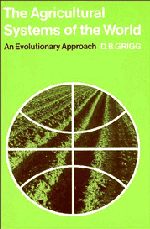Book contents
- Frontmatter
- Contents
- Acknowledgements
- 1 Introduction
- PART ONE
- PART TWO
- 5 Shifting agriculture
- 6 Wet-rice cultivation in Asia
- 7 Pastoral nomadism
- 8 Mediterranean agriculture
- 9 Mixed farming in western Europe and North America
- 10 Dairying
- 11 Plantations
- 12 Ranching
- 13 Large-scale grain production
- 14 Conclusions
- Appendix: Regions of plant domestication
- Notes
- Bibliography
- Index
- Frontmatter
- Contents
- Acknowledgements
- 1 Introduction
- PART ONE
- PART TWO
- 5 Shifting agriculture
- 6 Wet-rice cultivation in Asia
- 7 Pastoral nomadism
- 8 Mediterranean agriculture
- 9 Mixed farming in western Europe and North America
- 10 Dairying
- 11 Plantations
- 12 Ranching
- 13 Large-scale grain production
- 14 Conclusions
- Appendix: Regions of plant domestication
- Notes
- Bibliography
- Index
Summary
Ranching, or extensive commercial grazing, has many points of resemblance to pastoral nomadism, and indeed at first sight it appears to be merely a more economically advanced form of it. Yet it has a different distribution and a different origin.
Ranching now occupies a smaller area than it did 100 years ago. Since then the humid margins of the semi-arid and arid areas in which ranching is now found have been occupied by farmers who not only produce beef cattle, and sheep for mutton and wool, but grow fodder crops and cash crops, for example in the Great Plains of the United States, the wheat-alfalfa belt of the humid pampa of the Argentine, the wheat-sheep belt of Australia, and the Canterbury Plains of South Island, New Zealand. The extensive occupation of ranching has been displaced by more intensive forms of land use, and ranching has, in most areas, been pushed into drier regions where it is generally the best use of the poor vegetation and soils.
Ranching is largly confined to the areas of recent European settlement, and was unknown in the Old World, except in South Africa, until recently. In the last thirty years however there have been attempts to convert nomadic pastoralists in Central Asia and parts of Africa into ranchers.
- Type
- Chapter
- Information
- The Agricultural Systems of the WorldAn Evolutionary Approach, pp. 241 - 255Publisher: Cambridge University PressPrint publication year: 1974



